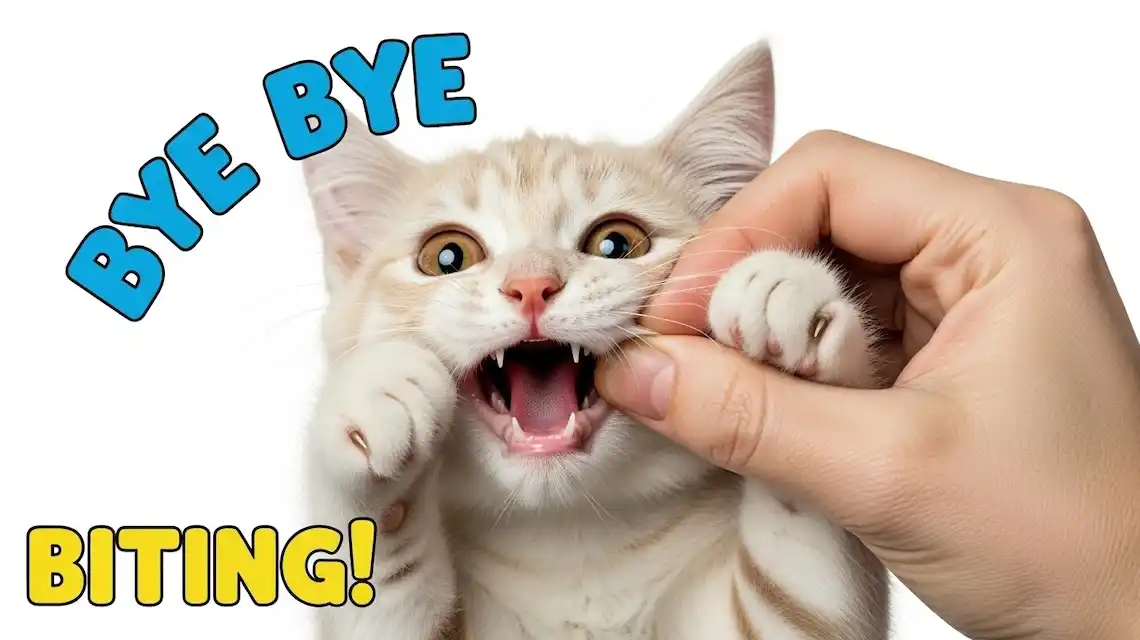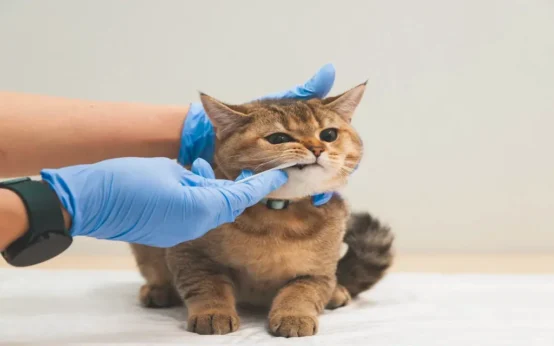Does your sweet cat turn into a tiny shark during play or cuddles? You are not alone. Biting is common, but it can hurt trust, spoil bonding, and scare kids or guests. The good news, cats can learn gentle behavior with clear, calm training.
This guide shows you how to train cat to not bite in a kind, proven way. Learn why cats bite, how to read early warning signs, and what to do in the moment. You will get step-by-step methods that teach soft mouths, redirect rough play, and reward the right choices. You will also see simple prevention tips that make good habits stick.
We start with the common causes, like overstimulation, teething, fear, and play that gets too wild. Then we move into daily training steps you can use right away, with short sessions and clear cues. Next, we cover prevention, from toy choices and routine to handling rules for the whole family. Finally, you will know when a vet or behavior pro should help, such as sudden biting, deep bites, or signs of pain.
Expect practical tips, plain language, and quick wins you can try today. No harsh methods, no confusion, just a calm plan that builds trust. With patience and consistency, your cat can play nicely, and you can enjoy cuddles without teeth. Ready to start training for a safer, happier bond?
Why Do Cats Bite? Understanding the Root Causes
Biting has different meanings for cats. Sometimes it is playful, sometimes it is a warning, and sometimes it signals pain. When you know the cause, you can pick the right response and teach safer habits. This makes how to train cat to not bite much easier and kinder for both of you.
Play Biting in Kittens and Young Cats
Kittens learn bite inhibition from their littermates. If they bite too hard, play stops, and they figure out how to use a softer mouth. Solo kittens or young cats adopted early may miss that lesson, so they practice on you.
Watch how and when biting happens. Short, structured play sessions help you spot patterns and prevent roughness.
- Common patterns: biting at hands during petting, sneak attacks on ankles, or excitement spikes at the end of play.
- Early cues: butt wiggle, pinned whiskers, dilated pupils, tail twitching.
Redirect energy, do not punish. Use toys that keep hands safe and teach clear rules.
- Use a wand toy or kicker, not fingers. If teeth touch skin, freeze, say “ow,” then end the game for 5 to 10 seconds.
- Offer chew-friendly outlets, like soft chew sticks or fabric kickers, especially during teething.
- Keep play short and frequent, about 5 to 10 minutes, 2 to 4 times a day.
- Rotate toys to keep interest high, and end with a small treat to complete the “hunt.”
This teaches that gentle play keeps fun going, and teeth on skin makes fun stop.
Biting from Fear, Stress, or Pain
Defensive biting often comes from feeling unsafe or unwell. If biting is sudden, severe, or out of character, call your vet first. Pain, dental issues, arthritis, or skin problems can make touch feel scary.
Watch for stress signals before a bite:
- Flattened ears, dilated pupils, stiff body, tucked tail, or piloerection.
- Hiding, growling, hissing, swatting, or sudden grooming.
- Changes in appetite, sleep, or litter box use.
Build trust with gentle, predictable handling.
- Pet where your cat prefers, often cheeks or shoulders, and stop at the first flick or freeze.
- Use slow blinking, calm voice, and treat pairing with touch to create positive links.
- Offer choice and escape routes, like high perches and safe rooms.
- Keep sessions short, end on success, and let your cat approach you.
When fear or pain eases, biting drops. Then training sticks, and your bond grows.
Step-by-Step Guide: How to Train Your Cat to Not Bite
If you want a simple plan for how to train cat to not bite, start with rewards, clear rules, and calm resets. You will teach your cat that gentle behavior earns play and treats, while biting quietly ends the fun. Stick to short sessions, consistent cues, and patient repetition.
Use Positive Reinforcement and Toys for Redirection
Reward the behavior you want, and redirect the rest. Here is a quick, beginner-friendly plan you can use today.
- Prepare your gear: soft treats, a wand toy, and a kicker toy. Add a clicker or use a marker word like “Yes.”
- Start a 5 to 10 minute play session. Keep your hands out of the game and use toys to create space.
- Mark and reward gentle play. When your cat bats the toy softly or disengages from chasing your hand, click or say “Yes,” then give a treat.
- Redirect teeth to toys. If your cat aims for skin, freeze for one second, then guide the mouth to a toy. Reward when the toy gets the bite.
- End on a win. After a few good reps, let your cat “catch” the toy, then give a small treat to complete the hunt.
- Repeat daily. Do 2 to 4 sessions each day for steady progress.
Clicker basics, made easy:
- Click or say “Yes” the moment your cat does the right thing.
- Follow the click with a treat every time so the marker keeps its meaning.
- Keep timing tight, within one second of the behavior.
Helpful tips:
- Use interactive toys that put distance between your skin and your cat’s teeth.
- Rotate toys to keep interest high.
- Never use your hands as toys. Fingers that wrestle become fingers that get bitten.
- For teething kittens, offer safe chew toys or fabric kickers to satisfy the urge to bite.
Consistency matters. Reward soft paws and calm bites on toys, not skin. Over time, your cat will choose the option that gets the good stuff.
Set Boundaries with Time-Outs and Ignore Bad Behavior
When biting happens, end the fun without drama. You are teaching that teeth on skin stops access to you.
- Calmly stop play. Drop the toy and stand up. Walk away for 1 to 2 minutes.
- Do not talk, scold, or stare. Silence short-circuits attention seeking.
- Return and restart with a toy. Reward gentle behavior right away.
Use ignoring to extinguish attention bites:
- Laptop bites or ankle nips for attention get no reaction.
- Fold arms, look away, and stand still, or step into another room for 60 to 120 seconds.
- When your cat sits or plays with a toy, mark and reward that calmer choice.
Age-specific examples:
- Kittens: Use very short time-outs, 30 to 60 seconds. They rebound fast, so restart play with a wand toy and end with a treat.
- Young adults: Use the full 1 to 2 minutes. Add structured play before peak energy times, like morning and early evening.
- Seniors: Check for pain first. Keep time-outs gentle and brief, and focus on slow, predictable interactions.
Safety reminders:
- No yelling, tapping, or scruffing. These increase fear and can escalate bites.
- If a bite breaks skin, stop the session for the day and clean the wound.
Pair redirection, rewards, and quiet time-outs, and you will see fewer bites and more self-control. This is the heart of how to train cat to not bite with kindness and clarity.
Preventive Tips and Tools to Stop Cat Biting for Good
Prevention starts with routine, outlets for energy, and clear rules. If your cat has a predictable day, safe ways to play, and places to scratch, biting drops. Pair these tips with your training plan for how to train cat to not bite, and you will see steady progress.
Create a Bite-Free Play Routine
A daily play schedule channels hunting energy into safe outlets. Short, focused sessions beat one long burst.
- Aim for 2 to 4 sessions a day, 5 to 10 minutes each.
- Use a wand toy to keep distance between teeth and skin. Guide the toy in arcs, bushes, and stops, like real prey.
- Add a laser pointer only as a chaser. Always finish with a catchable toy and a small treat so your cat completes the “hunt.”
- End each session with a calm cool-down. Let your cat hold a kicker, then reward a sit or a quiet pause.
Keep interest high with simple rotation:
- Rotate toys every few days. Hide half, keep half out, then swap.
- Use varied textures, like feathers, fabric snakes, crinkle balls, and soft kickers.
- Store wand toys out of reach for safety and novelty.
Reduce frustration biting with structure:
- Schedule play before peak energy times, like morning and evening.
- Follow play with a meal. Hunt, eat, groom, sleep is your template.
- Offer safe chews for kittens, like fabric kickers, to soothe teething.
Round it out with the environment:
- Provide at least two scratching posts per cat, both vertical and horizontal.
- Add perches and hiding spots to reduce stress.
- Consider pheromone diffusers or vet-approved calming aids if your cat is tense.
- Spay or neuter when advised by your vet, since hormones can fuel rough behavior.
When to Call in a Vet or Behaviorist
Some biting needs expert eyes. Watch for red flags:
- Sudden aggression, especially in a friendly cat.
- Biting paired with hissing, growling, or stiff posture.
- Pain signs, like flinching at touch, limping, or avoiding the litter box.
- Deep bites that break skin, or bites that keep getting worse.
- Changes in appetite, sleep, grooming, or social behavior.
Get help when issues persist after you add routine, play, and redirection. Start with your vet to rule out pain or illness. If medical causes are clear, consult a certified cat behavior professional. Reputable sources like the ASPCA provide guidance and directories to find qualified help. Early support prevents rehearsed biting and protects your bond.
Conclusion
Teaching a gentle mouth comes down to timing, consistency, and choice. You have a clear plan for how to train cat to not bite: read early signals, redirect teeth to toys, reward soft play, and use calm time-outs when needed. Pair that with a steady routine, short daily play bursts, and a stress-smart home. If biting changes fast or seems painful, loop in your vet before training further.
Start small today. Pick one cue, one toy, and a five-minute session. Mark and treat the calm moments, then pause when teeth touch skin. Track little wins, like softer paws or shorter recoveries after play. Those small steps add up to real trust.
Stay patient and keep your tone light. Cats learn best when they feel safe, have control, and know what earns rewards. Over a few weeks, you will see fewer nips, better self-control, and a stronger bond.
Thanks for reading. Share your progress or your biggest challenge in the comments, and help another cat parent who is working on the same goal.
Related post: What Fruits Can Cats Eat?
Stop Cat Biting: Practical FAQ
Why do cats bite during play?
Most bites come from play that looks like hunting. Fast hands trigger chasing and grabbing. Use toys that keep distance, like wand toys, so your hands never become the target.
How do I teach my cat that hands are not toys?
Only play with toys, never with fingers or feet. If teeth touch skin, freeze, say “ow” once, then end play for 10 to 15 seconds. Resume with a toy. Repeat every time.
What should I do the moment my cat bites?
Stop all movement. Avoid pulling your hand away fast, that can trigger more biting. Go still, mark it with “ow,” then step away and pause play. Return with a toy when calm.
Does punishment work for biting?
No. Yelling, squirting, or hitting raises fear and can worsen aggression. Use calm timeouts, redirection to toys, and reward gentle behavior.
How do I prevent overstimulation bites while petting?
Watch for early signs, like tail flicks, skin ripples, ears turning, or a hard stare. Pet for short sessions, focus on cheeks and chin, and stop before these signs show. Let the cat choose contact.
My kitten is teething. Is biting normal?
Yes, teething peaks around 3 to 6 months. Offer chew-safe toys, like rubber chew sticks or soft dental toys. Keep sessions short and frequent to burn energy.
What toys help reduce biting?
Use wand toys, kicker toys, and small toss toys. Rotate toys every few days to keep interest high. Store wand toys out of reach when not in use.
How long and how often should I play?
Aim for two to three sessions daily, 10 to 15 minutes each. End each session with a small treat or meal to mimic a hunt, catch, eat cycle.
Can clicker training help stop biting?
Yes. Mark and reward calm sits, target touches, and gentle nose boops. Train short, fun sessions. A trained cat has better impulse control.
What if my cat bites only one person?
That person likely triggers play or handles the cat differently. Standardize rules. No hand play, stop when signs show, and keep sessions short. Ask that person to feed and play with toys to build a positive link.
Are there medical reasons for sudden biting?
Yes. Pain, dental disease, thyroid issues, or skin pain can cause irritability. If biting starts suddenly or worsens, book a vet exam.
How do I handle night biting at feet or hands?
Schedule a late play session, then feed a small meal. Keep bedroom dark and boring. Wear socks, tuck sheets, and shut the door if needed during training.
Should I use taste deterrents on my skin?
No. Do not put bitter sprays on your hands. Use them on objects, like cords or furniture, if safe for pets and materials. Read labels first.
How do I stop bites around food or toys?
Trade, do not grab. Toss a high-value treat a short distance, then remove the item while the cat eats. Train “drop” with treats so the cue is clear and safe.
What if bites break the skin?
Wash with soap and water right away. See a doctor, cat bites can infect easily. Report changes in behavior to your vet or a certified behaviorist.
How long will training take?
Most cats improve in 2 to 4 weeks with steady practice. Consistency matters. Every family member must use the same rules.
When should I call a behavior professional?
Seek help if bites are frequent, draw blood, or seem unpredictable. A veterinary behaviorist or certified behavior consultant can create a tailored plan.
Quick checklist to cut biting fast
- Stop hand play, switch to wand toys and kickers.
- Play 2 to 3 times daily, then feed.
- Watch body language, stop before arousal peaks.
- Use brief timeouts after any bite.
- Reward calm behavior and gentle touches.
- Rule out pain with your vet if biting is new or severe.




 Dog Trick Training for Beginners
Dog Trick Training for Beginners  Gingivitis Cats Symptoms Every Pet Parent Should Know
Gingivitis Cats Symptoms Every Pet Parent Should Know  How to Make Dog Cookies at Home
How to Make Dog Cookies at Home  Wet Food or Dry Food for Cats?
Wet Food or Dry Food for Cats?  What Is the Healthiest Hamster Breed for Your Home?
What Is the Healthiest Hamster Breed for Your Home?  Cat Food Intolerance Symptoms: How To Spot Them Early
Cat Food Intolerance Symptoms: How To Spot Them Early